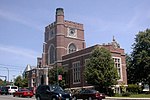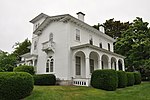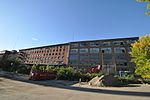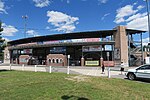Soldiers and Sailors Monument (Nashua, New Hampshire)

The Soldiers and Sailors Monument in Nashua, New Hampshire is an American Civil War memorial. Its cornerstone was laid on May 30, 1889, and the monument dedicated on October 15, 1889. The monument is located in central Nashua within the triangle formed by Concord, Amherst, and Nashville streets. The monument is a square, castellated column of New Hampshire granite from Nashua on a base of Quincy granite, atop which stands a figure of Victory, dressed in classical Roman garments and holding an American shield and a laurel wreath. Its base is ornamented with bronze statues of a soldier and sailor, and bronze reliefs depicting the Goddess of Liberty overseeing the reconciliation of the South with the North, an emancipation scene with a Union soldier extending a scroll to a kneeling figure, and the sinking of the Alabama by the Kearsarge. At its front is a sculpture of a saddle draped with cavalry clothing and equipment; at the rear is a sculpture of Civil War-era weapons. The design for the monument was made by T. M. Perry, of Messrs. Frederick & Field, who carved the Victory, erected the monument, and did all its granite work. The sailor was modeled by S. J. O'Kelley and cast by Melzar Hunt Mosman. The soldier was modeled by Caspar Buberl and cast by the Henry Bonnard Bronze Company. The artillery sculpture was made and cast by Melzar Hunt Mosman, as were the Emancipation bas-relief and the two lettered panels. The statue of Victory, cavalry sculpture, and sinking of the Alabama were modeled by Beattie & Brooks. On bronze plaque on lower front of monument: On bronze plaque on lower back of base: On relief plaque on base: On relief plaque on base:SINKING OF THE ALABAMA BY THE KEARSARGE JUNE 19, 1864
Excerpt from the Wikipedia article Soldiers and Sailors Monument (Nashua, New Hampshire) (License: CC BY-SA 3.0, Authors, Images).Soldiers and Sailors Monument (Nashua, New Hampshire)
Concord Street, Nashua
Geographical coordinates (GPS) Address Nearby Places Show on map
Geographical coordinates (GPS)
| Latitude | Longitude |
|---|---|
| N 42.765555555556 ° | E -71.4675 ° |
Address
Concord Street 1
03064 Nashua (Ward 3)
New Hampshire, United States
Open on Google Maps











